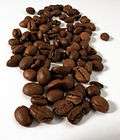Kapeng barako
Kape Barako, also spelled Baraco (English: Barako coffee) is a coffee varietal grown in the Philippines, particularly in the provinces of Batangas and Cavite. It belongs to the species Coffea liberica. The term is also used to refer to all coffee coming from those provinces. Barako is the Filipino term for the male stud of an animal, and has become associated with the image of a tough man.
History
Barako takes its name from the Tagalog word for ‘wild boar’ who are fond of dining on the plant’s leaves and berries.[1]
The first Barako tree was a cutting from Brazil planted in the 1800s in Barangay Pinagtung-Ulan, Lipa City, Batangas( http://lipatourism.wordpress.com/culture/lipa-city-history/) by the family of Don H. Macasaet .[2] Barako coffee has strong taste, flavor, and has a distinctively pungent aroma. All coffee grown in Batangas is generically called Barako.
In the 1880s, the coffee industry in the Philippines collapsed due to an infestation dubbed as "Coffee rust" as well as tough competition from coffee growers in South America and Vietnam. This has caused Kape Barako growers to shift to other crops, which has threatened the varietal with extinction.[3]
Preparation
Kape Barako is prepared using a drip brewing device, French press, or by simply pouring hot water unto the grounds and filtering the mixture using a piece of cloth. Barako is best sweetened with honey or brown sugar. Barako can be used to make espresso and other espresso-based drinks.
Comparison with other coffee varieties
Barako (Liberica) is not a common coffee variety, accounting today for less than 1% of commercial coffee grown, although it is abundant in Southeast Asia especially in the Philippines. It is also produced in Malaysia, although it is typically not exported because most producers operate small farms and sell locally and to the tourist market. It has the largest leaves and beans of all the coffee varieties.

The shape of the beans is not symmetric, which is unique among the four remaining commercial species (Arabica, Robusta, Excelsa and Liberica). One side is lower than the other side, creating a distinctive "point" or hook at the bottom. The furrow in the middle is generally jagged rather than straight as in other coffee species. The coffee fruits grow on trees that reach 30' tall, and harvesting is usually done by accessing the fruit using ladders. Its taste is said to be superior to Robusta, and most Filipino coffee drinkers prefer Barako to Arabica. Arabica-Barako and Excelsa-Barako blends are popular and create a cup with broader flavor range.
Other uses
Aside from being a beverage, Kape Barako is also used as a body scrub in spa treatment.[4]
Batanguenos use Kapéng Barako as an alternative to soup as part of the rice dish. It is usually used when eating Tapa or any dry/fried dish.
Kapeng Barako from the Batangas region is now gaining popularity among consumers, mainly for its unique, authentic, and traditional appeal.[5]
Kape Barako brands
- Mrs. Owl Coffee Kapeng Barako
- Kick-Start Coffee Philippine Barako
- Silcafe Farmer's Brew
- KKK Coffee
- Gourmet's Barako Batangas
- Batangas Brew
- Cafe de Lipa
- Kapeng Barako
- Figaro
- Kape Amadeo
- Siete Barako
- Taza Mia Coffee
References
- ↑ Nuguid-Anden, Charmaine. Figaro Coffee Company Case Study (PDF). UK: New Academy Of Business. p. 6.
- ↑ White House Farm Philippines, retrieved 2012-10-14
- ↑ Gutierrez, Tuesday, Save the Barako Coffee, OhmyNews, retrieved 2007-01-25
- ↑ Yoon, Rowena dela Rosa, "Well-being" Mania Goes Tropical, retrieved 2007-01-25
- ↑ Rodriguez, Ma. Cecilia. "Mrs. Owl Coffee Kapeng Barako". Mrs. Owl Coffee Kapeng Barako. Retrieved 27 February 2016.
